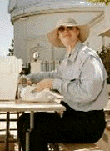|
|
This topic comprises 2 pages: 1 2
|
|
Author
|
Topic: Speed controlled CD player
|
|
|
|
|
|
|
|
|
|
|
|
|
|
|
|
|
|
|
|
|
|
|
|
|
Frank Angel
Film God

Posts: 5305
From: Brooklyn NY USA
Registered: Dec 1999
|
 posted 09-26-2005 09:52 AM
posted 09-26-2005 09:52 AM





Welp, this whole thing all came about because I was able to get my hands on a beautiful IBTech print of an old sponsored film RHAPSODY OF STEEL produced for US Steel by John Sutherland Productions. What makes this such a great film is, aside from the stunning animation, the score is by Dimitri Tiomkin (conducting the Pitsburgh Symphony Orchestra) and it is something to give you goosebumps.
This must have been one huge production for US Steel because they sunk a lot of $$$ into it. First off, they hired Tiomkin to compose and conduct; they struck 35mm and 16mm Technicolor prints, they pressed an LP with a bi-fold album and 6 pages including pictures from every section of the film as well as the entire text, and they got John Sutherland to produce the whole thing.
At any rate, at one time I found out that USS actually had a 4 track mag, Technicolor print (which they didn't even know they had), probably one of only a handful if that many that were struck. I booked it and ran it once in the big theatre and it looked and sounded sensational. Only a year later I tried to book it again and I was told that USS had closed down that PR department, they no longer dealt with there free sponsored film bookings and had the "junk" all the "old film" that was in that office. John Sutherland Productions has long been shut down, and even if the original stereo elements did exist at one time, then who knows where they are now or if even they were distroyed.
Then I get the idea that I could use that LP that was released simultaniously with the picture (and which USS sent to me as a promotional copy which I still have). One side of this LP had the exact film score with the Gary Merrill naration and the other side had just the Tiomkin score, sans voice-over. I figured I could dump the LP to Protools, clean up all the pops and scratches, then burn it to a CD and marry the CD to the film so as to get the stereo sound. There is no lipsync, so I thought just a bit of control would have gotten me to where I needed to be.
Now comes the horror. What I ASSUMED was a stereo LP (why would they release a symphonic work that was originally recorded in 4 tk stereo as a mono LP?) was actually only mono, much to my dismay. And this after I had spent a good 10 hours in protools eliminating LP pops and scratches. So the whole exercise is for naught. The soundtrack on the film is as good as what's on the LP in terms of a mono track. At least I don't have to spend any more time trying to clean the LP audio. But what a disappointment.
As for mono soundtracks....there are DOZENS of films that were originally released in full 70mm 6 trk stereo which, in 35mm, have only mono versions remaining. The studios routinely junked the mag prints because they were less likely to be needed for general circulation in the era before Dolby. Listen, I've had to run great titles in mono sound because I just couldn't get any mag prints. Would you believe before the restoration of MY FAIR LADY and THE SOUND OF MUSIC, I had to run these titles in MONO sound? And no, Peter, God didn't make them that way; in fact, when they are played in mono sound, He weeps. Yet, the DVDs were readily available with the full multichannel soundtracks. I once tried, in a totally haphazard way just to see if it would work, I tried to lock the 35mm print of THE BELLS ARE RINGING to the DVD. When I say lock, I just mean get them going in perfect sync and see how long they would stay together. Much to my amazement, once I got them in lip-sync, they stayed in sync for an entire 20 min reel (projector with a synchronous motor). It convinced me that if you had a good print with practically no splices, a simple motor control might be all that is needed to keep the two close enough for presentation, at least for one or two shows. It might take a sound guy as well as a projectionist, but that's a small price to pay. For longer runs, then Brad's method might do the trick. In the art house end of the business, there are LOTS of Roadshow titles that haven't gotten the R.Harris treatment and languish with only mono 35mm prints. And yes, I know, I could have put in 70mm heads, well, at the time that I ran MY FAIR LADY, CBS, who for some bizzar reason owned the rights, told me there was not a single runable 70mm print that she could have given me even if I had 70mm projectors.
Think about it: MY FAIR LADY, SOUND OF MUSIC, FIDDLER ON THE ROOF, CAROUSEL, THE KING AND I, all playing in mono sound (CAROUSEL AND THE KING AND I were beet red as well). Any idea how painful it was for me to have to run them this way? I had to seriously up my meds.
| IP: Logged
|
|
John Pytlak
Film God

Posts: 9987
From: Rochester, NY 14650-1922
Registered: Jan 2000
|
 posted 09-26-2005 10:42 AM
posted 09-26-2005 10:42 AM





I recall that "Carousel" and "The King and I" may have some new prints in circulation, from the restoration done by Cineric Labs in NYC:
http://www.kodak.com/US/en/motion/newsletters/inCamera/july2005/carousel.jhtml
quote:
Carousel, the 1956, 20th Century Fox musical originally filmed in CinemaScope55, has been completely restored by the New York City post-production facility Cineric, Inc. Directed by Henry King, with music by Rodgers and Hammerstein, Carousel features Gordon MacRae as Billy Bigelow and Shirley Jones as Julie Jordan.
Cineric used a mélange of analog and digital techniques to carefully restore the film. The goal was to preserve the original theatrical experience in all its glory. The CinemaScope55 format combined four channels of stereo sound with widescreen images composed in 2.55:1 width to height aspect ratio and recorded on 55mm color negative film. Traditional motion pictures of this era were recorded on 35mm film in 1.33:1 aspect ratio.
"Our philosophy is that a restored film should faithfully match every nuance recorded on the original negative to ensure that the movie-going experience is identical," says Cineric President and Founder Balazs Nyari. "It was obvious that in order to achieve that goal the digital work from start to finish needed to be done at 4K resolution."
In the past, restoration work has often been done at resolutions smaller than 4K. Cineric's staff felt that using 4K resolution from scan to film-out was necessary to truly capture all the information in the film elements. An additional benefit is that the film is prepared for any future improvements in delivery and distribution systems.
"Carousel is a cultural treasure," says Schawn Belston, executive director of film preservation for 20th Century Fox. "We believe it should be experienced by contemporary and future audiences the way it was intended to be seen and heard by the artists who created this classic film."
On their own internally designed, engineered, and fabricated 55mm transport mechanisms and optical printer gates, Cineric first converted the original 55mm film elements into a 35mm interpositive (IP). The newly designed 55mm optical liquid-gate permitted them to retain the proper aspect ratio for the IP while hiding much of the physical damage on the negative. Once this new 35mm anamorphic IP was manufactured, it was converted to 4K digital picture files with an Oxberry scanner.
Cineric's experienced team of preservationists used two Da Vinci revival Restoration workstations to address image flicker, remove scratches and dirt, repair density fluctuations and solve other problems. Since there was dye fading in the original elements and inconsistencies in overall color, a Discreet lustre color corrector was used to make these other necessary adjustments. All of these digital operations were conducted at 4K.
The project required an efficient pipeline for transporting trillions of bytes of digital picture data from the scanner to memory files, workstations and ultimately to a Lasergraphics Producer Digital Cine Film Recorder.
"If you're going to truly preserve the intentions of the original filmmakers, you can't compromise by down-rezzing the picture files at any stage," Nyari says.
The digital files were used to create four products: a series of 4K files totaling more than ten terabytes of digital picture data; an HD master for DVD creation; a fully timed 35mm CinemaScope answer print; and a new 35mm color film element for archiving.
"We look forward to applying what we have learned on this amazing project to the restoration of other classic films," says Nyari.
http://www.theasc.com/magazine/june05/postfocus/page1.html
quote:
True 2.55:1 35mm prints with four-channel sound on an SRD track printed between the perforations were made, with the image extending into the area currently used for an optical soundtrack. These prints required a special aperture plate, recentering of the optical center of the projector and recentering of the projector relative to the screen, plus a different focal-length lens. Few screening facilities are equipped for this, so from the preservation IP a reduced “letterboxed” IN was created that fit the 2.55:1 image within the standard 2.35:1 aspect ratio, with small black panels at the top and bottom and four-track Dolby Digital and analog SR optical tracks.
The decision to preserve the films in 35mm was made for historic as well as practical reasons, according to Belston. “While there is a lot of image area in the 55mm negatives, the film stocks of that era were primitive by today’s standards. Both Carousel and The King and I were made just three years after Kodak released its first color negative film stock. One reason Fox originally opted to go with the 55mm format was that the negative stocks were low-resolution and very grainy, and the larger image area compensated for that. With today’s fine-grained film stocks, a contemporary 35mm negative can have the resolving power that the 55mm system had back then.”
For Cineric, restoring the CinemaScope 55 pictures was both challenging and enlightening. “We learned that ingenuity and commitment can overcome barriers, and that know-how and experience are vital,“ says Balazs Nayari, Cineric president. “Use every tool at your disposal, and don’t be afraid to experiment and fail. From an equipment-design perspective, field flatness in a new printer gate coupled with the need to do liquid gate without bubbles was a real challenge. We also learned that digitizing the film at full 4K resolution does, in fact, yield the best results.”
From the first test through the final prints, the restoration of both films took nine months. Although Belston and Nyari are mum about the cost, Belston offers that “the digital solution [for film restoration] has become much more attractive in terms of both vastly improved technical quality and price.”
| IP: Logged
|
|
Bruce Hansen
Jedi Master Film Handler

Posts: 847
From: Stone Mountain, GA, USA
Registered: Dec 1999
|
 posted 09-26-2005 05:57 PM
posted 09-26-2005 05:57 PM




Jeff Joseph did a 3D Expo in LA a couple of years ago, and did sync stereo sound from a DVD (or some other source, I don't remember) to a mono print. The sound was loaded into a computer, and a lot of work had to be done to make it match up to the film. If I remember, there was some sort of clock signal generated by the projector, and feed to the computer to keep everything in sync. Someone did this for free, but it would have cost LOTS of money. There was also talk about a computer program that can "listen" to the sound from the film optical track, and keep a sound file (in the computer) in sync with the sound from the optical track. I looked for the threads on this subject on his forum, but they may have been lost when that forum's software was updated some time ago.
| IP: Logged
|
|
|
|
All times are Central (GMT -6:00)
|
This topic comprises 2 pages: 1 2
|
Powered by Infopop Corporation
UBB.classicTM
6.3.1.2
The Film-Tech Forums are designed for various members related to the cinema industry to express their opinions, viewpoints and testimonials on various products, services and events based upon speculation, personal knowledge and factual information through use, therefore all views represented here allow no liability upon the publishers of this web site and the owners of said views assume no liability for any ill will resulting from these postings. The posts made here are for educational as well as entertainment purposes and as such anyone viewing this portion of the website must accept these views as statements of the author of that opinion
and agrees to release the authors from any and all liability.
|

 Home
Home
 Products
Products
 Store
Store
 Forum
Forum
 Warehouse
Warehouse
 Contact Us
Contact Us




 Printer-friendly view of this topic
Printer-friendly view of this topic







![[Big Grin]](biggrin.gif)





![[Shrug]](graemlins/shrug.gif)






